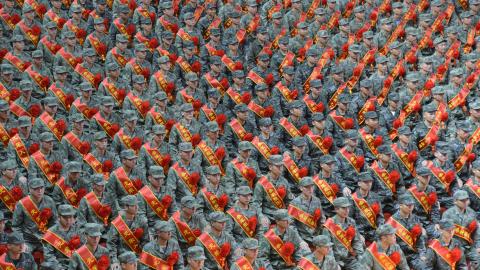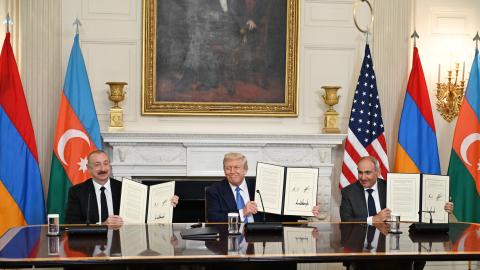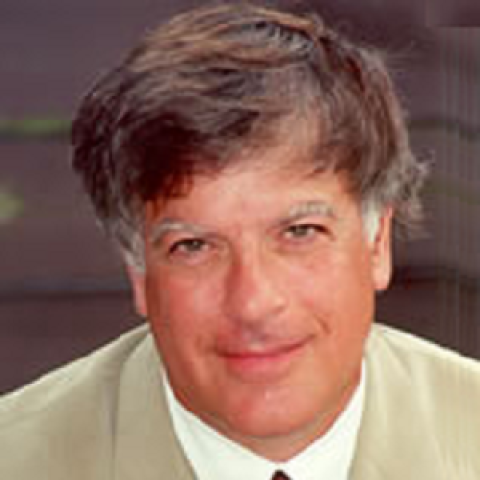On September 1, 2004, the children of school number one in Beslan, a town of 30,000 in the North Caucasus, were preparing for the first day of school. Suddenly, the air was filled with machine gun fire. A military truck pulled up and two dozen men with Kalashnikov assault rifles jumped out. Other terrorists appeared out of nowhere. The terrorists herded 1,200 students and parents into the gymnasium where they were held for 52 hours before a pitched battle broke out between the terrorists and Russian forces leading to the deaths of 332 persons, including 186 children. It was the worst terrorist act since September 11, 2001.
While it was going on, the Beslan standoff riveted the world's attention. Once it was over, however, the incident was largely forgotten. On September 4, 2004, the day after the storm of the school, bulldozers gathered the debris from the school, including children's notebooks and the body parts of the victims, and removed it to a garbage dump on the outskirts of town.
The survivors, however, wanted justice and they were plunged into emotional turmoil as they listened to the version of events of the Russian authorities who put the blame on the terrorists, exonerated officials of any wrongdoing (many of them were later promoted) and refused to listen to the survivors' accounts of what they had seen and experienced.
Some of the parents turned to a cult leader to help resurrect their dead children. Others, however, began their own investigation. They were joined by journalists, a commission of the North Ossetian parliament and finally, Yuri Saveliev, a member of the federal parliamentary investigative commission. Aided by testimony at the trial of Nurpashi Kulaev, a surviving terrorist, they carefully reconstructed what happened. The picture they present raises doubts as to whether Russia even today can remotely be considered a civilized country.
In the aftermath of the Beslan tragedy, three questions remain: could the attack have been prevented, were the Chechens willing to negotiate and who started the final, fatal battle. The answer to these questions presents a chilling portrait of the Russian leadership and its total disregard for human life.
It is now all but certain that the attack on the school could have been prevented. According to internal police documents obtained by the newspaper, Novaya Gazeta, the police knew four hours in advance that an attack on a school in Beslan was planned for September 1, 2004.The information came from a person named Arsamikov who was arrested in the city of Shali in Chechnya. The information, however, was never acted upon.
Equally puzzling, the terrorists trained for weeks without interference in the woods in the republic of Ingushetiya, which neighbors North Ossetia where Beslan is located although a bloody terrorist attack on June 21-22 had supposedly put Ingushetiya on high alert. They also traveled unimpeded to the school in several vehicles over roads that were supposedly heavily guarded.
Perhaps most unnerving, of 18 terrorists who were later positively identified, the majority were supposed to have been in prison. The second in charge among the terrorists, Vladimir Khodov, a Ukrainian convert to islam was arrested for rape and then released. He then was involved in two terrorist acts, a car bombing in Vladikavkaz and the derailment of a train. Despite this, for a month and a half before the Beslan events, he lived openly in his hometown spending long hours in the mosque. Other leaders of the terrorists were wanted criminals of many years' standing who also moved about freely in their home villages.
Besides indications that the terrorist act was preventable, there is evidence that the terrorists' real aim was not to kill the hostages but to negotiate a political settlement. The terrorists demanded that Alexander Dzasokhov, the president of North Ossetia, begin negotiations. The Federal Security Service (FSB), however, set up a crisis headquarters from which Dzasokhov was excluded and the FSB threatened to arrest him if he tried to go to the school.
Dzasokhov appealed for help to Ruslan Aushev, the former president of Ingushetiya, a critic of Putin, and made contact with Akhmed Zakaev, the representative of the Chechen resistance in London. On September 2, Aushev entered the school and left with 26 hostages, 15 children and 11 women. He also brought out a note with demands from Shamil Basayev, the terrorist leader, who had organized the attack but was not himself in Beslan. The existence of the note was concealed. The authorities stated that the terrorists had presented no demands.
In fact, the conditions proposed by Basayev were extremely moderate. He proposed independence for Chechnya in exchange for security for Russia. He said an independent Chechnya would not conclude any military or political agreements directed against Russia and would join the Commonwealth of Independent States. Finally, it said that although the Chechen rebels had no part in the 1999 apartment building bombings in Moscow and Volgodonsk that served as a pretext for the start of the Second Chechen War, the rebels were willing to take responsibility for them, an indication that Basayev believed the bombings were carried out by the FSB.
On September 3, at noon, Zakaev informed Dzasokhov that Aslan Maskhadov, the Chechen leader, was prepared to come to Beslan to mediate the crisis. Dzasokhov reported this to General Vladimir Pronichev, the head of the FSB operation. The appearance of Maskhadov would have almost certainly ended the crisis because it would have signified implicit Russian recognition of Chechen aspirations. The authorities, however, did not react to Maskhadov's proposal. Within an hour, the storm of the school had begun.
Of all the issues connected to Beslan, the most emotional for the survivors was the question of who shot first, provoking the massacre. Survivors testifying at the trial of Kulayev said that the Russians struck first, attacking the school with flamethrowers and grenade launchers. When officials denied that flamethrowers had been used, they presented the court with used tubes from flamethrowers that had been found in the area near the school. The implications of this discovery were harrowing. The flamethrower to which the tubes belonged shoots a capsule that on detonation creates a fireball and a shock wave capable of destroying everything in its path. It is impossible to use the weapon "surgically."
The version of the Beslan parents was supported by the findings of a commission of the North Ossetian parliament. In a report released November 29, 2005, the commission concluded that the first explosion was produced by either a flamethrower or grenade launcher fired from outside the building.
The most powerful confirmation, however, came in a report released by Yuri Saveliev, a member of the federal parliamentary investigative commission and a highly regarded expert on the physics of combustion. Saveliev, a Duma deputy, was the only such expert on the commission. Saveliev concluded that the first explosion was the result of a shot from a flamethrower from a fifth story building on a street near the school at 13:03. The second explosion came after 22 seconds and was caused by a high explosive fragmentation grenade with a dynamite equivalent of 6.1 kilograms shot from another five story building on the same street. The explosions, according to Saveliev, caused a catastrophic fire and the collapse of the roof of the school gymnasium that led to the deaths of the majority of the hostages. The order to put out the fire did not come for two hours, leading to a situation in which hostages who could have been saved were burned alive.
According to Saveliev, another 106 to 110 hostages then died after terrorists moved them from the burning gym to the school's cafeteria, which came under heavy fire from security forces using flamethrowers, rocket launchers and tanks. His analysis, in this way, supports the view of human rights activists that at least 80 per cent of the hostages were killed by indiscriminate Russian fire.
When Savleiev presented his conclusions to the other members of the parliamentary investigating commission, he was accused by the chairman Alexander Torshin, of "deliberate falsification." Saveliev then released his findings independently on August 29 and October 12. The release of the findings of the Torshin commission has been postponed indefinitely.
The evidence that is now available makes it clear that, despite Putin's promise to protect the hostages, the Russian forces attacked the school in Beslan according to classic military doctrine for destroying reinforced objects without the slightest regard for the lives of the hostages. This was done although agreement had been reached on negotiations that would have ended the crisis. There is also a possibility that the ease with which the terrorists took over the school cannot be explained as solely the result of official incompetence. The Russian authorities may have deliberately allowed the terrorists to take over the school in order to have an excuse to destroy them.
The sad reality is that 15 years after the fall of the Soviet Union, the role of the individual in Russia has not changed. He is seen as a means to an end not an end in himself. This is why the lives of the children of Beslan were written off the moment the school was seized, a fact to keep in mind lest we agree to Russian carte blanche in their own "neighborhood" or look again in Putin's eyes and see something we think resembles a soul.

















